The Google Nexus 9 Review
by Joshua Ho & Ryan Smith on February 4, 2015 8:00 AM EST- Posted in
- Tablets
- HTC
- Project Denver
- Android
- Mobile
- NVIDIA
- Nexus 9
- Lollipop
- Android 5.0
Battery Life
It goes without saying that battery life is one of the most important aspects of a mobile device. After all, a mobile device isn’t really mobile if it can only be used for an hour before running out of battery. In order to test this, we turn to our standard suite of battery life tests, which include our web browser battery life test, along with some compute-bound benchmarks to characterize battery life across various use cases.
However, as the Nexus 9 introduces such a unique CPU architecture, I felt that it was necessary to try and adequately capture the full extent of battery life. To this end, I’ve introduced a new test that is really quite simple but important, as we can start to separate display power from everything else since it can often be the single largest consumer of power in a test. In order to do this, everything that could run during a test is disabled, and the device is placed in airplane mode with the display at 200 nits. A white image is displayed on the screen from a full charge until the device shuts down.
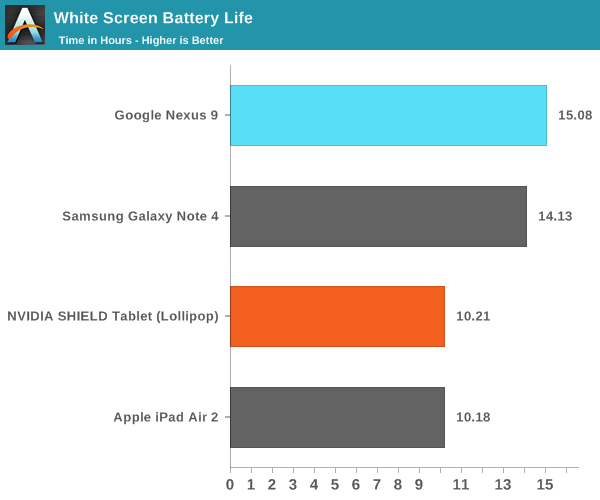
Interestingly enough, the display runtime on the Nexus 9 is about as good as it gets when compared to other devices for which we have data. I suspect we’re looking at the direct result of the large battery combined with an efficient display, as the Nexus 9 can last as long as 15 hours in this test compared to the iPad Air 2’s 10 hours.
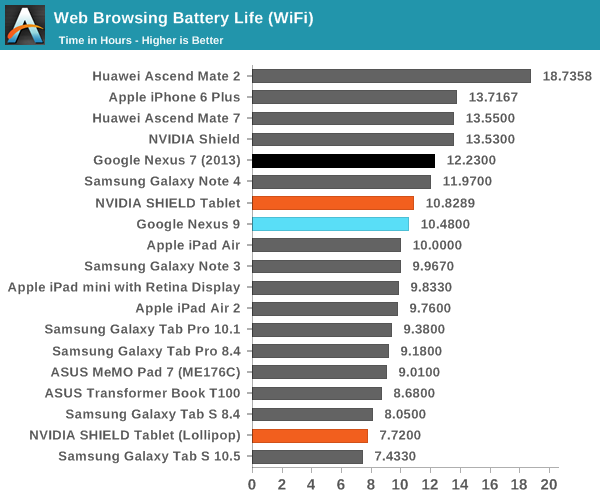
Unfortunately, the massive lead that we saw with the pure display test is significantly eroded in our web browser test. Our web test is primarily focused upon CPU, connectivity, and display efficiency. Seeing as how the Nexus 9’s display is far ahead of the iPad Air 2 and connectivity should be broadly similar in power efficiency, it seems that all of the efficiency gains from the display have gone into powering the Denver CPUs. It’s likely that process has a significant effect on this, so the more valid comparison is between SHIELD Tablet and the Nexus 9. At any rate, the Nexus 9 does manage to deliver solid battery life performance in this test which is definitely a good thing.
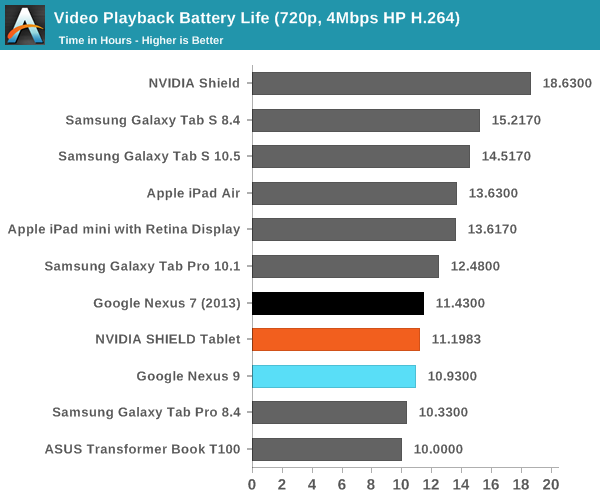
When we move to our pure video test, the Nexus 9 does have a minor regression when compared to the Nexus 7 (2013) and SHIELD Tablet. In this case, the AMOLED displays on the Galaxy Tab S line make for an easy victory due to the relatively high amount of black displayed in the content. The gap is closed between the two devices though, due to a reduced focus on SoC power.
While our web browsing test can give some idea of efficiency, there are often cases where more compute is directly used to support a better experience. To try and test for these compute-bound cases, we use Basemark OS II’s CPU battery life test and GFXBench’s T-Rex rundown for a GPU battery life test. As with the web browsing tests, these are run at 200 nits to keep things relatively equal.


In Basemark OS II, the Nexus 9 does a surprisingly good job as the CPU manages to keep incredibly high sustained performance. The large battery and efficient display seem to help to a significant extent.
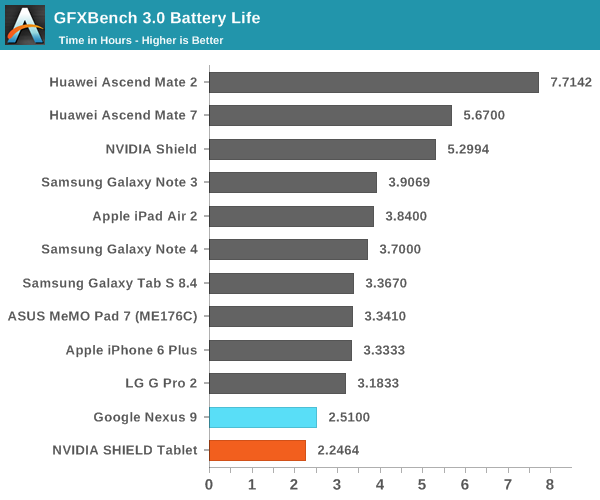
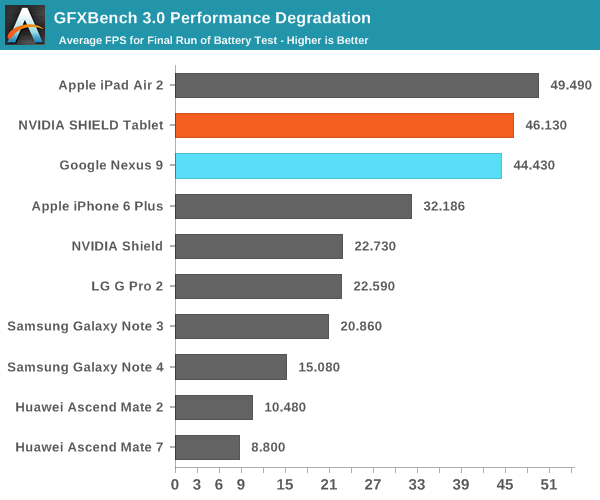
In GFXBench, it seems that not much changes overall. The GPU is definitely more power hungry than the PowerVR Series 6XT line-up and sustained performance is noticeably worse, but it’s in line with the SHIELD Tablet. End of run performance ends up a bit lower, but higher than one might expect. This is likely due to differing ambient temperatures. In practice, skin temperatures are about 45C in this test and localized to the top half of the device, and it’s likely that internal temperatures are around 80C as well. Seeing as how Tegra K1 can theoretically draw 33W in platforms such as the Jetson TK1 dev board with active cooling, it's incredibly impressive to see NVIDIA effectively keep such a powerful SoC within the constraints of a passively-cooled tablet.
Charge Time
While battery life is one part of the equation, charge time is an equally important aspect of overall battery life. To measure this, we measure the time from when charging begins to when the device reaches 100% charge. This is confirmed by taking measurements at the power outlet to make sure that power draw is below a certain level.
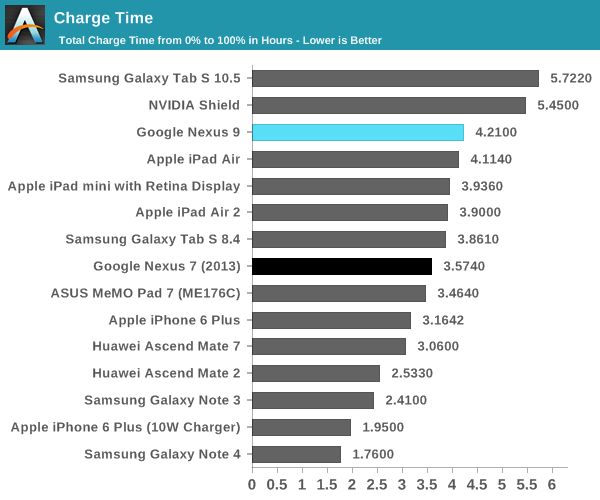
In this regard, the Nexus 9 is merely average for a tablet, although it does fall behind the competition as it uses a 5V, 1.5A charger for 7.5W instead of the 12-15W chargers that we’ve seen recently. It shouldn’t be a big issue, but in general this does mean that devices like the Galaxy Note 4 are actually better at battery life overall when compared to most tablets.










169 Comments
View All Comments
mkygod - Saturday, February 7, 2015 - link
I think so to. The 3:2 ratio is one of the things that Microsoft has gotten right with their Surface Pro devices. It's the perfect compromise IMOUtilityMax - Sunday, February 8, 2015 - link
I am a little perplexed by this comment. A typical user will be on the web 90% of time. Not only the web browser does not need to be natively designed or optimized for any screen ratio, but it also will be more usable on a 4:3 screen. So will the productivity apps. The only disappointment for me on the 4:3 screen would be with watching the widescreen videos or TV shows. Moreover, there is quite a bit of evidence than a lot of the next generation tablets will be 4:3. Samsung's next flagship tablet supposedly will be 4:3.gtrenchev - Wednesday, February 4, 2015 - link
Anandtech is becoming more and more boring last year. Sparse on reviews, short on tech comments, lacking on depth and enthusiasm. I can see Anandtech has become a just job for you guys, not the passion it was for Anand :-) And yes, his absence is definitely noticeable.George
Ian Cutress - Wednesday, February 4, 2015 - link
Was the Denver deep-dive not sufficient enough? Always welcome for comments.As for timing, see Ryan's comment above.
We've actually had a very good quarter content wise, with a full review on the front page at least four out of every five weekdays if not every weekday.
milkod2001 - Wednesday, February 4, 2015 - link
Why not to post on your forum some sort of suggestion box/poll where all could say what should get reviewed first so some folks won't cry where is the review of their favorite toy :) ?Impulses - Wednesday, February 4, 2015 - link
Because they'll still cry regardless, and they can't possibly work entirely based on readers' whim, doesn't make sense logistically or nor editorially... Readers might vote on five things ahead of the rest which all fall on the same writer's lap, they won't all get reviewed before the rest, or readers might not be privy to new hardware because of NDAs or cases where Anandtech can't source something for review.tuxRoller - Thursday, February 5, 2015 - link
While I enjoyed the review, I would've loved to have seen the kind of code driven analysis that was done with Swift.In particular, how long does it take for dco to kick in. What is the IPC for code that NEVER gets optimized, and conversely, what is the IPC for embarrassingly instruction-wise parallel code? Since it's relying on ram to store the uops, how long does the code need to run before it breaks even with the arm decoder? Etc.
victorson - Wednesday, February 4, 2015 - link
Are you guys kidding? Better late than never, but heck.. this is freaking late.abufrejoval - Wednesday, February 4, 2015 - link
Thanks for making it worth the wait!The in-depth analysis of Denver is uniquely Anandtech, because you can't get that anywhere else.
And while Charly D. is very entertaining, the paywall is a bit of an impediment and I quite like again the Anand touch of trying to be as fair as possible.
I was and remain a bit worried that there seems to be no other platform for Denver, which typically signals a deeper flaw with an SoC in the tablet and phone space.
While I'm somewhat less worried now, that Denver might be acceptable as a SoC, the current Nexus generation is no longer attractive at these prices, even less with the way the €/$ is evolving.
Taneli - Wednesday, February 4, 2015 - link
eDRAM cache à la Crystalwell would be interesting in a future Denver chip.